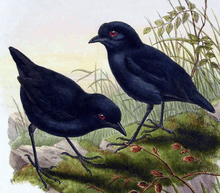Lesser melampitta
The lesser melampitta (Melampitta lugubris) is a medium-sized enigmatic terrestrial songbird of mountain forests of New Guinea. It is the only species in the genus Melampitta. It is now classified (with the greater melampitta) in the family Melampittidae,[2] but in some other sources it is variously considered close to or in the Orthonychidae (logrunners), Paradisaeidae (birds of paradise), Corcoracidae (Australian mud-nesters), Cnemophilidae (satinbirds) or Monarchidae (monarch flycatchers).[3]
| Lesser melampitta | |
|---|---|
 | |
| Scientific classification | |
| Kingdom: | Animalia |
| Phylum: | Chordata |
| Class: | Aves |
| Order: | Passeriformes |
| Family: | Melampittidae |
| Genus: | Melampitta Schlegel, 1871 |
| Species: | M. lugubris |
| Binomial name | |
| Melampitta lugubris Schlegel, 1871 | |
| Subspecies | |
|
Melampitta lugubris longicauda | |
A local name, used by the Ketengban people of the Jayawijaya Mountains, is golík.[4]
It is approximately 18 cm long and has an all-black plumage with long legs and short tail. Both sexes are almost similar, distinguished by the color of the iris. The male has crimson red iris while the female's are dark brown.
The lesser melampitta builds dome-like nest in the forests. The diet consists mainly of insects.
Widespread and a common species throughout its habitat range, the lesser melampitta is evaluated as least concern on the IUCN Red List of Threatened Species.[5]
Footnotes
- BirdLife International (2012). "Melampitta lugubris". IUCN Red List of Threatened Species. 2012. Retrieved 26 November 2013.CS1 maint: ref=harv (link)
- Schodde, R.; Christidis, L. (2014). "Relicts from Tertiary Australasia: undescribed families and subfamilies of songbirds (Passeriformes) and their zoogeographic signal". Zootaxa. 3786 (5): 501–522.
- Jønsson & Fjeldså (2006)
- Diamond & Bishop (1999)
- BLI (2004)
References
- Diamond, Jared & Bishop, K. David (1999): Ethno-ornithology of the Ketengban People, Indonesian New Guinea. In: Medin, Douglas L. & Atran, Scott: Folkbiology: 17–46. MIT Press. ISBN 0-262-63192-X
- Jønsson, Knud A. & Fjeldså, Jon (2006): A phylogenetic supertree of oscine passerine birds (Aves: Passeri). Zool. Scripta 35(2): 149–186. doi:10.1111/j.1463-6409.2006.00221.x (HTML abstract)
